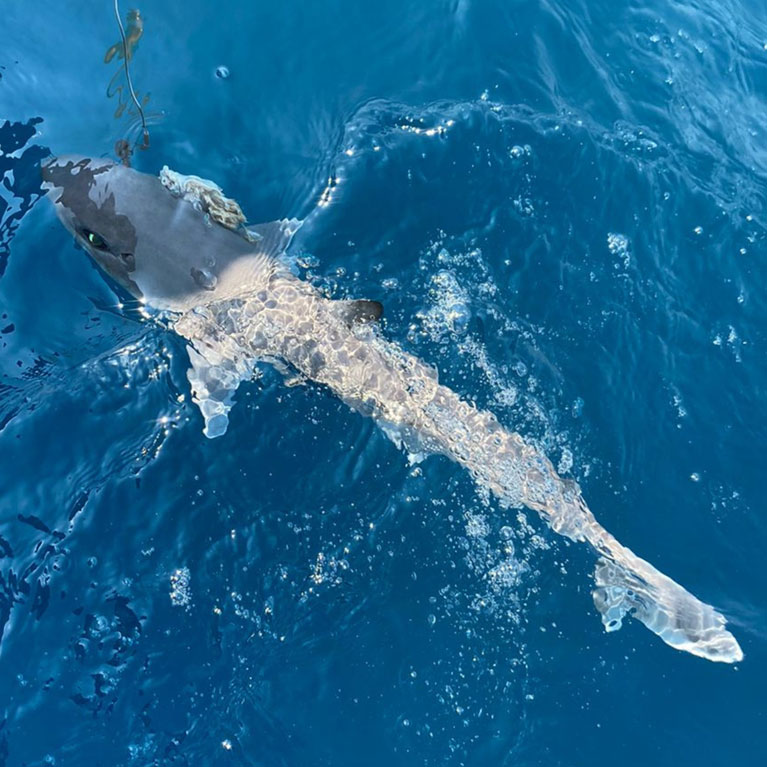Deep trouble: measuring the impact of fishing on Caribbean deep-sea sharks
Ana is helping to grow the body of knowledge that exists for the Guatemalan Caribbean’s sharks and rays. Using different survey methods, from monitoring landing sites to involving fishers and community members, her focus species (which include the IUCN Red-Listed gulper shark, kitefin shark and bluntnose sixgill shark) have expanded with the incursion of fishing into deeper waters to include new records for the region. Ana wants to know what the impact of fishing is on these sharks and will use her data to help delineate a no-take marine protected area (MPA) to mitigate impacts in the deep.
I was born in Guatemala City, the most urbanised area of this Central American country. Despite the urban environment, I had the privilege of growing up in a natural setting, fostering my love for outdoor activities and honing my skills for observing nature. This upbringing naturally led me to pursue a Bachelor’s degree in biology at the Universidad de San Carlos de Guatemala.
When I completed my studies, my path converged with Blue World Foundation (BWF), an organisation dedicated to safeguarding shark and ray populations in Guatemala. While my interests and study subjects have evolved over...


Determining fishery impact and promoting the protection of deep-water chondrichthyans in the Guatemalan Caribbean
To determine the fishing impact on chondrichthyan populations through the catch composition and catch rate estimations, and to provide data to support the implementation of a no-take zone to prevent the expansion of deep-water fishing operations.
The project has relevance because fishing in deep waters has expanded in the Caribbean due to the decline of shallow coastal fisheries. Data on the impact of fishing on deep-water chondrichthyans are needed to establish management regulations. This project can make a difference to the conservation of these species because fishers and other community members will be engaged in gathering data, which will increase their awareness of the species’ vulnerability to fishing.
Three of the main species are at risk according to the IUCN Red List – gulper shark Centrophorus granulosus (Endangered), kitefin shark Dalatias licha (Vulnerable) and bluntnose sixgill shark Hexanchus griseus (Near Threatened) – due to their late age at maturity, low fecundity and long reproductive cycles, and the intense fishing pressure. Also, with the expansion of fishing to deep waters, other chondrichthyans have been recorded for the first time in the Guatemalan Caribbean. These include sharpnose sevengill shark Heptranchias perlo and dwarf sicklefin chaemera Neoharriotta carri (both Near Threatened), roughskin spurdog Cirrhigaleus asper (Data Deficient), and Atlantic sixgill shark Hexanchus vitulus, Cuban dogfish Squalus cubensis and whitesaddled catshark Scyliorhinus hesperius (all Least Concern). There are probably more deep-water species in the study area because it is connected to an extensive section of the Caribbean through the Cayman Trench, a narrow linear basin up to 6,000 metres (19,685 feet) deep. Although most deep-water chondrichthyans are widely distributed, it is important to determine potential impacts on their populations throughout their distribution to avoid an increased risk of extinction.
Although more is now known about chondrichthyans in the Guatemalan Caribbean, we still need to learn about the impact of fishing on them. To do this we have to understand the seasonal occurrence of fishing and the catch composition in terms of species and by sex, size and stage of maturity. Although the Guatemalan government has decreed the fishing season for sharks closed from May to August and for rays from July to mid-September in the Caribbean, fishing in deep water is currently not recognised, so the government is not aware of the expansion of this fishing and its potential impact on deep-water species. The continuous monitoring of landings and the fishery-independent surveys are needed to fill knowledge gaps about the chondrichthyans vulnerable to fishing in the study area.
- To determine the fishing impact on chondrichthyans through catch composition and catch rate estimations.
- To provide data to support a no-take zone to prevent the expansion of deep-water fishing.

